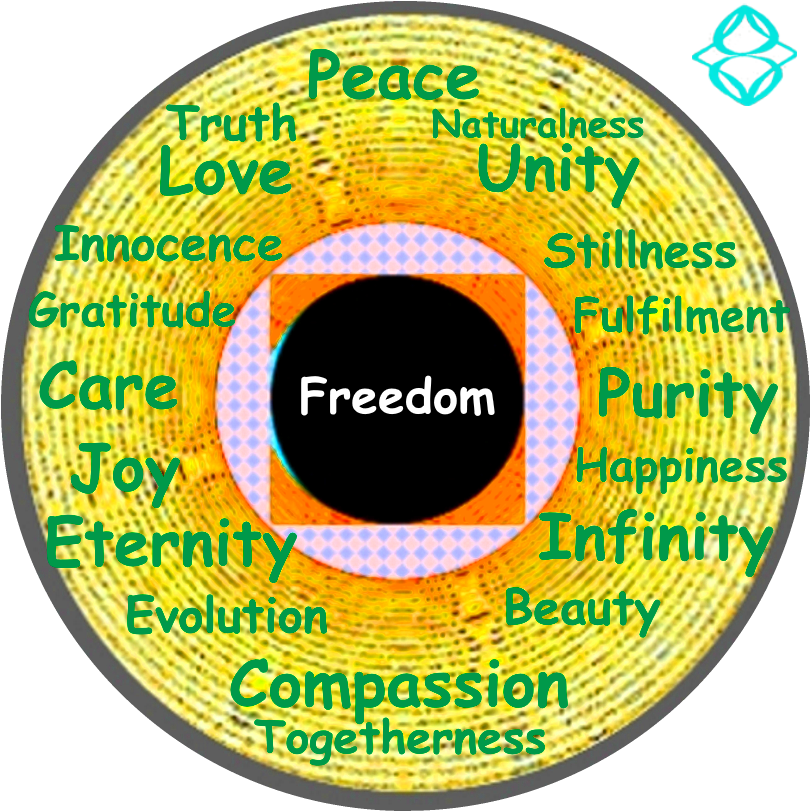Many have written saying they feel that traumatic states and contractions are so many and so pervasive, that they seek all help possible to get free. Feeling caught in old trauma or PTSD – especially when the cause can’t be found or doesn’t seem to justify the response – is indeed a living hell that can hijack our lives and by default, that of our families. Following are some insights that could support a deeper movement into peace.
Periods of depression, fear, negativity, rage, despair, dread – these are physical phenomena recognized by all of us. At times, background states of suffering can suddenly flip to the foreground and it seems to be only through distraction into something ‘pleasant’ that we’re able to drive them back inside.
In cases of trauma, a set of triggers – often our unique sensitivities involving our worst nightmare (that which must never happen) – can launch us through a rabbit whole into a separate universe of the traumatic state. It’s bleak in there. Although a traumatic rabbit hole can feel self-righteous, truthful (in a bitter way) and temporarily empowering, it’s lonely and blocks both receptivity and expression. We are unable to take in information, and expression feels almost shameful.
1.Be Mindful
 Awareness of inner suffering is perhaps the most critical aspect of healing. Just the inner recognition of negative feelings, pain, resentment or stress creates space in the inner world. Awareness of feelings and emotions brings care towards the dissonant energy fields. The agreement to experience them, without too much commentary from the mind, brings the care for which this energy longs.
Awareness of inner suffering is perhaps the most critical aspect of healing. Just the inner recognition of negative feelings, pain, resentment or stress creates space in the inner world. Awareness of feelings and emotions brings care towards the dissonant energy fields. The agreement to experience them, without too much commentary from the mind, brings the care for which this energy longs.
Of all the mindfulness exercises, breathing in the present moment and breathing out the past is perhaps the most useful for trauma. This is because whatever is cramped in feelings and emotions is the effect of the past. It belongs to the past. The in-breath offers a freshness of the taste of the air and the living presence of the movement of the body. The out-breath offers release. It can be noticed that negative emotions all almost indistinguishable on the in-breath, and with the out breath they are released with the old air. That gives us a break with every in-breath of presence.
Trauma often affects our breathing – we tend to breath more shallowly the more stressed we become, or even hold our breath. As such, it can be helpful to put greater emphasis on the out breath. Blow out as if you were blowing out through a straw. Let the in-breath come naturally, of itself.
In training like this, you will find that the healing breath becomes unconscious – the moment a suffering becomes triggered, sometimes even before the mind has got a hook. It can even carry on loving you though states of sleep, where an enormous amount of healing takes place.
2.Radical Acceptance

Form is empty of a separate self, but it is full of everything in the cosmos. The same is true with feelings, perceptions, mental formations, and consciousness.
Thich Nhat Hanh
We all want to be free of trauma, that is, we would like to get rid of it. This drive to reject the trauma, by healing it out of existence, is actually echoing the same movement through which the trauma was created in the first place. A rabbit hole of trauma is part of our energetic experience that has been amputated from the whole, cut off from our ‘normal’ experience. Tragically, this severance was often aided and abated from family and society around us that couldn’t contain our suffering. This split in the psyche, after that, is maintained by an agenda to keep it out of sight; to hide it from the outer world and if possible from our own consciousness. As such, the agenda to get rid of trauma has the power accentuate the split, or create further splits in other directions, as we design a trauma-free form for ourselves and others.
The situation that created the trauma happened. It can’t be undone. It happened. Healing comes not through eradication of the past, but through the adding of time and space to the experience to the degree that the trauma no longer defines who we are, and no longer determines our direction in life.
As part of trauma involves the social field, it can be tremendously helpful to learn how to communicate trauma to others in certain contexts. This doesn’t have to be a drama. It can be a relaxed statement that you’re sensitive in that area, or a genuine admission that you’re experiencing a traumatic memory right now, and would rather take some time to relax. Remember, the charged emotions that cause you to feel the trauma is socially unacceptable don’t need to be expressed (that can make the sense of rejection around the trauma worse), just the request for another’s respect towards the pain in that moment. These small communications create bridges between that inner, taboo zone and the outer world. Also they immediately alleviate secondary degrees of isolating fear, guilt and shame around the trauma zone. They are precious.
3.That Dreadful Strength
 When a trauma or severe shock occurs, there is a rip in the fabric of time and space our of which our habitual ‘normal’ reality is composed. The experience doesn’t fit the collective mind, it leaves us for a while hovering outside of time and in no clear location. This sense – of existing beyond the consensual fabric of reality – has a sharp truthfulness about it. It feels more ‘real’ than the sleep-state around us. It is deeply empowering because it has this incredible sense of inner truth.
When a trauma or severe shock occurs, there is a rip in the fabric of time and space our of which our habitual ‘normal’ reality is composed. The experience doesn’t fit the collective mind, it leaves us for a while hovering outside of time and in no clear location. This sense – of existing beyond the consensual fabric of reality – has a sharp truthfulness about it. It feels more ‘real’ than the sleep-state around us. It is deeply empowering because it has this incredible sense of inner truth.
In trauma, this severance in the trance of habitual reality can adorn the traumatic universe itself with a feeling of deeper truth or ultimate reality. All the suckers out there are drinking tea and eating cake, but “I” know suffering. “I” know death. “I” know that the tea and cake will end in tears.
This sense of truth, combined with the hidden power of the incredible self righteous victim carries and emotional charge and can actually function as a retreat position for some from failure in the more superficial aspects of life. “Don’t mess with me,” are Private Detective told me once, when I threatened to sue his company for stalking me, “I’ve been in the war in Lebanon.” “Don’t mess with me,” I replied, smiling, “I’ve hung out many nights in Brixton.”
The secret reward of exemption from normal social rules can lead to a subconscious abuse of the trauma and a subtle agenda to keep it in the armory of protection against life and the living. The use of greater past pain to de-throne some discomfort in the present can be a short term fix that spirals between lesser and greater suffering, rather than the healing movement of deep surrender to feeling the feeling, which can lead to integration.
Radical acceptance of the traumatic happening means that we are able to hold it in experience in such a way that we can offer it to the universe, to a higher power, or to the greater consciousness. This offering can only be made through our permission to experience the energy. There is no bypass.
4.Slow Motion, Little Pieces

“Since at any point of time and space I can be both the subject and the object of experience, I express it by saying that I am
both, and neither, and beyond both.”
Nisargadatta Maharaj
As stated above, the agenda to get rid of trauma completely and all at once can reinforce the traumatic split, rather than facilitate a reintegration of frozen energy into the whole. Moving very slowly with our consciousness towards the feeling, or memory and staying each time, just a little bit longer, can be tremendously supportive in deeper healing.
In addition, the sampling of little pieces, rather than the whole ‘event’ has an effect of realization. It’s enough just to take one detail of chronological and/or experiential memory, and to stay there with patience and curiosity.
The often mono-tonal repetition of the “story” can be a verbatim way to wall the rabbit hole of trauma way from direct experience. Be inquisitive. What shoes were you wearing? What color were the walls? How did the air smell in that moment. What sounds could be heard.
By taking just all the time to experience just a little detail of a trauma, we begin to bring it back to the land of the living – the only movement it ever needed.
5.Alternating Universes
 This one can take some practice. When you find yourself down the rabbit hole, try to consciously drop it (this is not repressing it, but disengaging for a moment). Move to another position with your consciousness where you feel happy. It can be the pleasant feeling of the air on the face, or you could stroke your own shoulders lovingly and enjoy that caress. You could even think of something or someone that makes you happy. Stay in the better place just long enough to get the experience of it. Then go back to the rabbit hole. Experience the rabbit hole, just for a while, then go back again to the pleasant space. This kind of alternation between perspectives can be radically liberating, building a trust and consolidation in the living awareness that is here, irrespective of the nature of experience. This ability to oscillate brings a new mastery and greater freedom within our inner world, unlocking the instinctive freeze/flight/fight responses of fear.
This one can take some practice. When you find yourself down the rabbit hole, try to consciously drop it (this is not repressing it, but disengaging for a moment). Move to another position with your consciousness where you feel happy. It can be the pleasant feeling of the air on the face, or you could stroke your own shoulders lovingly and enjoy that caress. You could even think of something or someone that makes you happy. Stay in the better place just long enough to get the experience of it. Then go back to the rabbit hole. Experience the rabbit hole, just for a while, then go back again to the pleasant space. This kind of alternation between perspectives can be radically liberating, building a trust and consolidation in the living awareness that is here, irrespective of the nature of experience. This ability to oscillate brings a new mastery and greater freedom within our inner world, unlocking the instinctive freeze/flight/fight responses of fear.
6.Expansion is Generous
 When we feel love or happiness, we tend to naturally allow it to expand to be shared with others. When we suffer however, we often fear that this “bad” energy could hurt others, that it could infect the world. As a result, we energetically contract. This contraction also involves shielding our suffering with an inexpressive face of pretended behaviors of being “OK”. Think of when you’ve really been hurt by a lover, and they ask what’s going on. “Nothing,” is often the automatic response.
When we feel love or happiness, we tend to naturally allow it to expand to be shared with others. When we suffer however, we often fear that this “bad” energy could hurt others, that it could infect the world. As a result, we energetically contract. This contraction also involves shielding our suffering with an inexpressive face of pretended behaviors of being “OK”. Think of when you’ve really been hurt by a lover, and they ask what’s going on. “Nothing,” is often the automatic response.
There is a depth of misconception here. There is beauty in open suffering, and the authenticity of emotion, even when it is sadness, pain or fear. The natural response of others in feeling the purity or nakedness of this energy is care. People react badly to pretense. They feel shut out. When others are allowed, even energetically, inside our naturalness, the response tends to be either loving care, or considerate space. Don’t be fooled into believing that shrinking your truth into the background is protecting someone else!
7.Suffer for the Whole
 You might not have heard about inherited trauma and the legions of research that is affirming that psychological trauma, traumatic patterns and PTSD can be passed down through our genes from one generation to another. Integrating even a little piece of trauma within yourself is a tremendous service to all your family.
You might not have heard about inherited trauma and the legions of research that is affirming that psychological trauma, traumatic patterns and PTSD can be passed down through our genes from one generation to another. Integrating even a little piece of trauma within yourself is a tremendous service to all your family.
In addition, the frozen energy of fear, anger or despair of a traumatic contraction is not your private property. It’s human energy from the shared human field. It effects others whether or not you want it to. It creates a resonance of suffering on the planet, even before we begin acting out from our traumas and perhaps causing still more suffering for others.
Each particle of pain we process individually is of service to the whole. Dedicating the experience of suffering (when it is here) to others – to suffer it if possible on behalf of others – is tremendously worthwhile. It can even create an expansion that means we are able to invite added volume. If you suffer a fear of abandonment, for example, take into your heart a child that has been abandoned, whether or not you know them, and suffer this pain also for them. Suffer for others in worse situations than yourself – be there for them, with them.
This movement again bridges the rift between the habitual universe and the traumatic one. It undoes isolation, and opens the heart towards the whole, and also towards the last one we always forget, ourselves.
My fear is always in relation to the known, not to the unknown.
~ J. Krishnamurti




